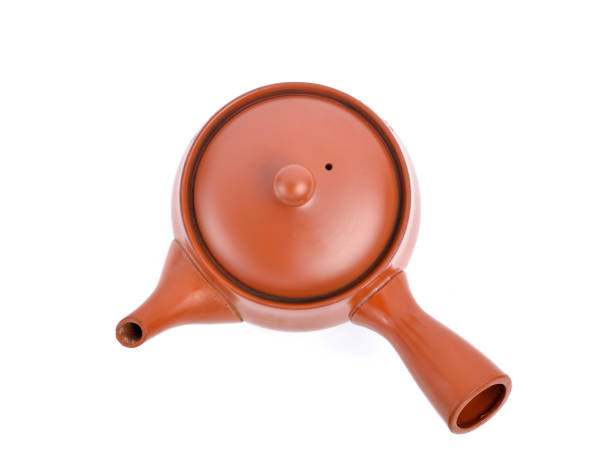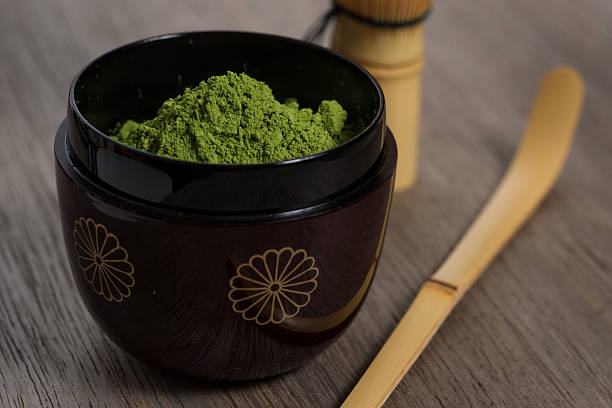Matcha

Matcha is a vibrant green powdered tea derived from specially grown green tea leaves. It originated in Japan and is known for its unique preparation method and distinct taste.
Packed with antioxidants and nutrients, matcha offers a smooth, earthy flavor with a subtle sweetness, making it a popular choice for both traditional tea ceremonies and modern culinary delights like lattes, desserts, and smoothies.
Camellia Sinensis

Camellia sinensis is the botanical name for the tea plants, the source of all true teas, including green, black, and white tea, oolong tea, and pu-erh. Native to East Asia, this evergreen shrub is cultivated in various regions worldwide for its leaves' infusion.
The unique processing methods and growing conditions give rise to the diverse flavors and characteristics found in different types of tea, making Camellia sinensis a vital and cherished plant in the world of tea production.
Catechin
Catechins are a group of natural antioxidants found primarily in tea, particularly matcha and other green tea. They belong to the larger family of flavonoids and are known for their health-promoting properties, including their ability to scavenge free radicals and support cardiovascular health.
Ceremonial Grade Matcha Powder
Ceremonial tea powder, a term that originated in the Western world, is synonymous with the finest and most exquisite grades of matcha, akin to those used in traditional Japanese tea ceremonies. Crafted from green tea leaves that thrive in shaded environments, this premium powder boasts a brilliant green hue and offers a velvety, delicate flavor profile.
While the concept of ceremonial grade matcha may have its roots in the Western world, it beautifully embodies the spirit of the Japanese tea ceremony tradition. Each meticulous preparation and thoughtful sip symbolizes a profound connection to the ideals of harmony, respect, and mindfulness.
Chashaku

Chashaku is a traditional Japanese tea scoop used in the preparation of matcha, powdered green tea. Usually made from bamboo, chashaku has a thin, curved shape, allowing tea practitioners to measure and transfer the precise amount of matcha powdered tea powder used for each serving.
The use of chashaku is an integral part of the Japanese tea ceremony, reflecting the attention to detail and mindfulness that characterizes this revered cultural practice.
Chasen

Chasen is a Japanese bamboo whisk designed specifically for whisking matcha powder into a frothy, smooth consistency during the traditional tea preparation process.
Crafted from a single piece of bamboo, chasen features finely split prongs that effectively aerate the matcha, creating the desired froth and ensuring even distribution of the powder throughout tea bowl. This essential tool in the art of the Japanese tea ceremony showcases the craftsmanship and dedication to precision that defines this time-honored ritual.
Chawan

A chawan is a traditional Japanese tea bowl in which matcha is prepared and served. It often comes in various sizes and designs.
Culinary Grade Matcha Powder
Culinary grade powder refers to a lower-quality matcha intended for cooking and culinary applications rather than traditional tea ceremonies. It is made from green tea leaves that are usually coarser and harvested first harvest tea or later in the season, resulting in a slightly bitter and less vibrant flavor compared to ceremonial grade matcha.
Despite its lower quality, culinary grade of matcha powder is valued for its affordability and versatility, making it a popular ingredient for various matcha-infused recipes like smoothies, lattes, desserts, and savory dishes.
Genmaicha

Genmaicha, also known as "brown rice tea," is a unique and popular Japanese matcha green tea blend. It combines green tea leaves with toasted brown rice, giving it a distinctive nutty and roasted flavor profile.
The addition of brown rice not only enhances the taste but also adds a pleasant aroma to the tea. Genmaicha is cherished for its mild and approachable taste, making it a favorite choice for those new to green tea and an enjoyable daily beverage for tea enthusiasts.
Koicha

Koicha is a type of matcha preparation used in the Japanese tea ceremony, characterized by its thick and intense consistency. Unlike the more common usucha (thin tea), koicha requires a higher concentration of matcha and less water.
The result is a rich, velvety texture with a sweet and complex flavor profile, making it a cherished treat reserved for special occasions in the world of traditional tea ceremonies.
Kyusu

Kyusu is a traditional Japanese teapot, distinguished by its side handle and small spout, designed for brewing green tea. Typically made from clay or ceramic, the kyusu's shape and material help retain heat and enhance the tea's flavor.
Its fine mesh strainer ensures a smooth pour, preventing tea leaves from escaping into the cup. This teapot is cherished for its functionality and cultural significance, reflecting the art of tea preparation and serving in Japanese tea ceremonies and daily tea rituals.
L-theanine
L-theanine, a naturally occurring amino acid abundant in tea leaves, especially in green tea, is renowned for its capacity to induce relaxation and tranquility within the mind, all while preserving wakefulness. This unique attribute has made it a sought-after component in the realm of natural relaxation aids.
Moreover, L-theanine is frequently paired with caffeine for its ability to foster a state of heightened alertness and improved cognitive performance. This dynamic duo provides individuals with an energy boost that is both focused and free from the jitters, rendering L-theanine a favored supplement among those in pursuit of balanced mental acuity and vitality.
Nibancha
Nibancha, a distinctive category within the realm of Japanese green teas, designates the second harvest of tea leaves during the annual growth cycle. This harvest follows the initial gathering of early spring leaves known as the first flush or "shincha" and precedes the final autumn harvest, known as "bancha."
Renowned for its bolder flavor profile, Nibancha stands in stark contrast to the delicate nuances of the first flush. It offers a well-rounded taste experience with a hint of increased astringency, making it a preferred choice for those who appreciate a more robust tea.
Saemidori

Saemidori is a cultivar of green tea plant primarily grown in Japan, known for its vibrant green color and rich umami flavor. This tea variety is derived from the Yabukita cultivar, with a unique blend of the Asatsuyu and Yabukita plants.
Saemidori is highly sought after for its excellent balance of sweetness and astringency, making it a preferred choice for producing high-quality sencha and matcha teas. Its distinct characteristics have earned Saemidori a reputation as a favored cultivar among tea enthusiasts and a valuable asset in the Japanese tea industry.
Sencha

Sencha, a beloved and extensively consumed Japanese green tea, has earned its reputation for a refreshing and distinctly grassy flavor profile. Crafted from the tender, young leaves of the tea plant, a meticulous process involving steaming, rolling, and drying is employed to safeguard the leaves' vibrant green hue and their rich nutritional attributes.
What sets Sencha apart is its remarkable antioxidant content, prominently featuring catechins. This green tea variety is cherished not only as a daily beverage but also as an integral component of Japanese tea ceremonies, signifying the profound reverence the country holds for its centuries-old tea culture. Sencha embodies a harmonious blend of flavor and tradition, making it an enduring favorite in the world of green teas.
Matcha Crema
Matcha crema is a term that refers to the creamy and frothy layer that forms on top of a traditional thin Matcha tea. This froth is created during the process of whisking powdered matcha with hot water, resulting in a luxuriously creamy and slightly bubbly texture on the surface of the tea. Matcha crema is a prized characteristic in the world of matcha preparation, signifying a well-prepared and finely whisked matcha bowl. It not only enhances the visual appeal of the tea but also contributes to its overall texture and taste. Matcha enthusiasts often seek to achieve the perfect matcha crema when preparing and enjoying their tea.
Matcha Shading
Matcha shading refers to the unique cultivation process of matcha tea leaves, where the plants are deliberately grown under shade for several weeks before harvest. This shading technique enhances the chlorophyll content in the leaves, resulting youngest tea leaves that in a bright green colour and a distinct flavor profile.
The reduced exposure to sunlight also encourages the production of amino acids, particularly L-theanine, which contributes to the tea's sweet and umami taste and makes shaded matcha highly prized for its exceptional quality and health benefits.
Mizusashi

A Mizusashi is a container used to hold fresh water for rinsing and cleaning utensils during a Japanese tea ceremony.
Natsume

A Natsume is a small lidded container used to store matcha powder.
Tencha

Tencha is a type of green tea that serves as the precursor to matcha. It is produced using the same shading process as matcha, where the tea leaves are grown under shade to boost chlorophyll and amino acid levels produce tea leaves.
However, unlike matcha, tencha leaves are not ground into a fine powder but are instead kept whole or slightly crushed, preserving their unique shape and flavors. Tencha is often enjoyed for its rich umami taste and is appreciated by tea connoisseurs for its distinctive characteristics.
Umami
Umami is one of the five basic tastes, alongside sweet, sour, salty, and bitter. It is often described as a savory or meaty taste and is attributed to the presence of certain amino acids, such as glutamate, in food.
Umami can be found in a variety of ingredients, including tomatoes, mushrooms, soy sauce, aged cheeses, and seaweed. Its addition to dishes enhances the overall flavor profile, creating a satisfying and deeply enjoyable culinary experience.
Usucha
Usucha is a type of matcha preparation in the Japanese tea ceremony, known for its lighter consistency compared to koicha (thick tea). It is made by whisking a smaller amount of matcha powder with a larger quantity of hot water, resulting in a frothy and thin tea.
Usucha offers a more delicate and refreshing flavor, highlighting the subtle grassy notes of matcha and is often enjoyed as a daily beverage in Japan, showcasing the country's appreciation for the art and ritual of tea drinking.
Yuzu-kukicha

This is a type of kukicha (twig tea) that is flavored with yuzu, a citrus fruit commonly used in Japanese cuisine. It offers a unique twist on traditional green tea.




